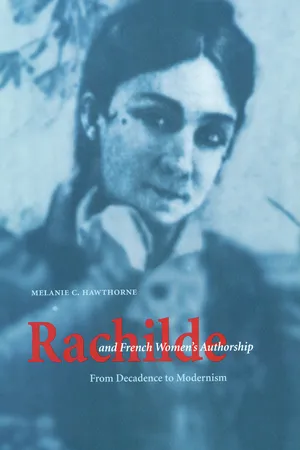
- 304 pages
- English
- PDF
- Only available on web
About This Book
Under the assumed name Rachilde, Marguerite Eymery (1860–1953) wrote over sixty works of fiction, drama, poetry, memoir, and criticism, including Monsieur Vénus, one of the most famous examples of decadent fiction. She was closely associated with the literary journal Mercure de France, inspired parts of Oscar Wilde's The Picture of Dorian Gray, and mingled with all the literary lights of the day. Yet for all that, very little has been written about her. Melanie C. Hawthorne corrects this oversight and counters the traditional approach to Rachilde by persuasively portraying this "eccentric" as patently representative of the French women writers of her time and of the social and literary issues they faced. Seen in this light, Rachilde's writing clearly illustrates important questions in feminist literary theory as well as significant features of turn-of-the-century French society. Hawthorne arranges her approach to Rachilde around several defining events in the author's life, including the controversial publication of Monsieur Vénus, with its presentation of sex reversals. Weaving back and forth in time, she is able to depict these moments in relation to Rachilde's life, work, and times and to illuminate nineteenth-century publishing practices and rivalries, including authorial manipulations of the market for sexually suggestive literature. The most complete and accurate account yet written of this emblematic author, Hawthorne's work is also the first to situate Rachilde in the broader social contexts and literary currents of her time and of our own.
Frequently asked questions
Information
Table of contents
- CONTENTS
- ILLUSTRATIONS
- ACKNOWLEDGMENTS
- ABBREVIATIONS FOR WORKS BY RACHILDE
- INTRODUCTION: On Writing Biography: In which the author pays a visit to Périgueux and makes a detour to Galveston
- 1860, FEBRUARY 11: Women as Outsiders: In which Marguerite Eymery (Rachilde) is born, a werewolf appears, and traps are both set and sprung
- 1870, OCTOBER 29: The Ambivalence of the Paternal: In which Captain Eymery is taken prisoner
- 1875, JANUARY OR EARLY FEBRUARY: The Cultural Injunction to Silence: In which Rachilde is engaged, appears to attempt suicide, and meets a ghost who delivers an important message
- 1876, MARCH 1: Woman as Medium: In which séances are held, Madame Eymery meets “Rachilde,” and doubles mysteriously appear
- 1877, JUNE 23: Authority, Authorship, and Authorization: In which Rachilde publishes her first story and Victor Hugo authorizes her
- 1884, MAY–JULY: The Politics of Publishing: In which Monsieur Vénus is published and the French police take an interest in Rachilde
- 1884, DECEMBER 12: Writing as Cross-Dressing: In which Rachilde applies for permission to cross-dress and become a writer
- 1885, A THURSDAY IN MARCH: Marriage and the Woman Writer: In which Rachilde meets Alfred Vallette and marries him, despite some second thoughts
- 1887, FEBRUARY 26 (A SATURDAY): The Photograph Never Lies: In which a front page brings attention to Rachilde’s hair
- 1889, OCTOBER 25: The Cultural Legitimacy of the Woman Writer: In which Rachilde’s daughter is born and questions are raised about legitimacy
- 1890, NOVEMBER 10: Imagining the Self: In which Rachilde’s first play is performed and some mirrors are looked into
- 1894, A TUESDAY: Male Anxiety at the Fin de Siècle: In which Rachilde, cupbearer to the symbolist gods, meets Alfred Jarry
- 1900, DECEMBER 10: Women and Education: In which Rachilde’s mother is admitted to the asylum of Charenton and some deficiencies in Rachilde’s education become apparent
- 1925, JULY 2: Women and Surrealism: In which Rachilde gets into a bun fight
- 1928, JUNE: Gender Anxiety in French Modernism: In which Le Prisonnier is published and Rachilde acts rather queerly
- 1953, APRIL 4: On Minding: In which Rachilde is reunited with Lison
- NOTES
- BIBLIOGRAPHY
- INDEX